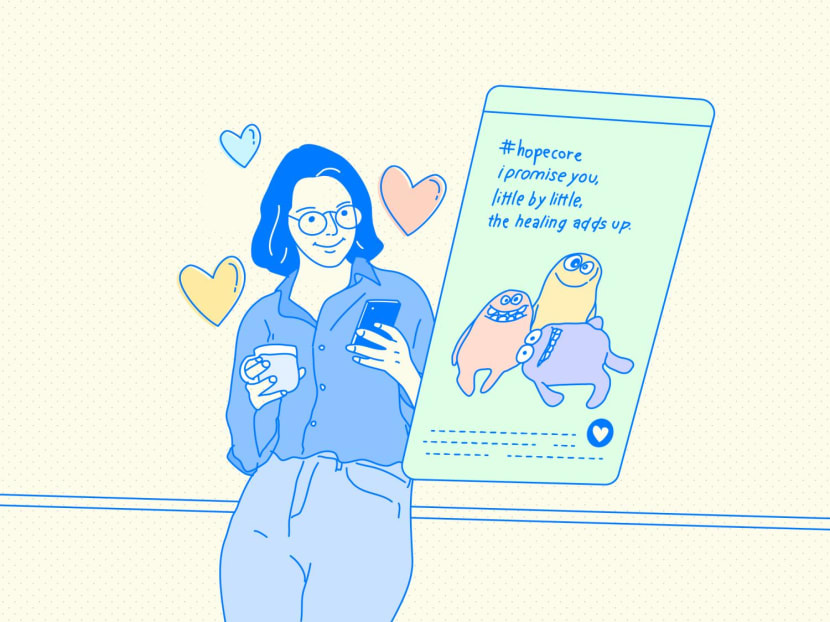Gen Zen: Frequent doses of positive content can be comforting, but does such 'hopecore' really improve one's mental health?

(Illustration: CNA/Samuel Woo)
SINGAPORE — Years ago, I remember chancing upon a social media clip of a man, who had lost his ability to see colour as a child, putting on EnChroma glasses for the first time.
EnChroma glasses are a set of special lenses designed to improve the colour vision of people suffering from colour-blindness or colour deficiency.
It was a simple but beautiful moment as he marvelled at the ability to see different colours, something I’d taken for granted.
A woman also left a comment under the same video narrating her husband’s own experience with EnChroma glasses, and how they had spent so much time browsing the produce section at the grocery shop after that, because he couldn’t fathom how there were so many shades of the same colour.
The video is just one of a collection of similar uplifting clips I’ve saved in a folder on my social media pages.
They run the range from a lone flower blooming in the cleft of a rock on a sidewalk, to strangers sharing about their journey of recovering from an addiction.
I find myself turning to these videos several times a week, for an easy dose of comfort on days that feel a bit rough.
While I know it isn’t therapy, these small hits of positivity do help in the moment, serving as a motivational midday pick-me-up to get through the day or week, until I can give myself the proper self-care that I need.
I know many people around me who do this as well. Whether they have an organised folder or not, many of us turn to these little videos or collections of memes and photos frequently as a coping mechanism in a trend that has come to be known as “hopecore”.
WHY IS POSITIVE CONTENT SO COMFORTING?
Social media and mental health experts agreed that viewing positive or optimistic content could evoke feelings of “warmth, faith, and hope”, which may be a helpful perk during a stressful day.
Such content could also be comforting as it serves as a reminder of the transience of life and the universality of the human condition — offering viewers a way to see things from a different perspective.
Dr Andrew Yee, an assistant professor at the Singapore University of Technology and Design (SUTD), whose research interests lie in the intersection between digital technology and human development, said: “As life becomes increasingly fast-paced, we may feel disassociated with other people and the world at large.
“To find meaning, humans seek out experiences that provide a sense of resonance, to help us feel more connected to the world.
“Seeing bite-sized content about what it means to be human, focusing on the transience of life and the moments which makes us human, can be uplifting, especially when people are caught up in the busyness of everyday life.”
This has been supported by research studies, which found that consuming small “doses” of uplifting content on social media, could have positive emotional consequences, Dr Yee said.
Agreeing, the Singapore Association for Mental Health (SAMH) pointed out that when one is feeling down, the mind may get trapped in a downward spiral, making it seem like things would never improve.
Viewing positive or optimistic content could thus serve as a reminder to see things from a different perspective, and thus potentially break the pattern of downward spiraling.
COULD IT REALLY IMPROVE MENTAL WELL-BEING?
However, experts cautioned against turning to such positive content as the sole means of dealing with one’s negative emotions and stressors.
Ms Glenn Woo, a therapist at Singapore-based online counselling platform Talk Your Heart Out, said that while consuming optimistic content may be helpful to some after a stressful day, it may be of little use to those facing “unrelenting challenges” who would need more help addressing deeper issues.
“At its best, hopecore content can evoke feelings of warmth, faith and hope. But on the flip side, it has the potential to cause increased melancholy to someone who may already be struggling to feel hopeful or connected with others,” Ms Woo added.
Agreeing, SAMH said that simply relying on hopeful content would not be enough to solve a certain problem the person is facing.
While helpful, the impact of such content may ultimately be temporary if the person feels their circumstances cannot be changed.
“More importantly, the person needs to be given the space to acknowledge the situation that they are going through and yet (be) presented with alternative perspectives.
“Otherwise, positive content may come across as idealistic and lose the potential for positive influence and change.”
If viewers find that the challenging situations they are facing persist and affect their daily functioning, they may need to seek alternative support.
Some online users have also drawn parallels between hopecore and doom scrolling — where viewers subject themselves to excessive amounts of optimistic or positive materials instead of consuming copious amounts of depressive or negative content.
Acknowledging this, Dr Yee from SUTD said: “If social media use becomes excessive, it can (also) displace one’s time doing meaningful things that contribute to well-being.”
One way to check if one’s social media use is problematic is by asking ourselves if our social media use is a form of procrastination — which prevents us from doing something more worthwhile — or if it is goal-directed and used for a specific purpose in a way that does not affect other aspects of our lives too negatively.
AVOIDING THE TOXIC POSITIVITY TRAP
And while hopecore content can be immensely comforting, one should also be mindful of falling into the trap of toxic positivity.
A key characteristic of hopecore content — as opposed to toxic positivity — is that the former does not seek to diminish negative feelings or encourage people to mask how they really feel.
However, Ms Woo from Talk Your Heart Out said that if the content one is viewing is promoting the idea that negative feelings should be avoided or that one is “weak” for feeling them, it is very likely that such content is crossing the line into toxic positivity.
Therefore, it is important to assess what kind of feelings are evoked through the content consumed.
“Oftentimes, toxic positivity will evoke feelings of shame or guilt surrounding your situation or emotions, or even suggest that you should ignore the pain you feel,” Ms Woo added.
She advised that it may also be worthwhile to check the content’s source.
If there is a tendency for the creator to push content with the narrative of being positive regardless of one’s circumstance, or if there is an element of blaming viewers for not doing more to be positive or better, it is likely that the content could be leaning towards toxic positivity.
Agreeing, Dr Yee said: “I think as long as the fundamental message (of the content) does not dismiss the realities of hardship, then I believe it does not cross over into toxic positivity.
Ultimately, experts said that it is important to contextualise the content viewed within our own situations, and to assess how it makes us feel.
“One way for viewers to be mindful is to be aware and recognise the emotions that media content evokes in them. It really is emotion literacy in general,” Dr Yee advised.
Ms Woo said: “Social media content isn’t designed to help you with your specific issues — but can be a helpful tool to help you identify that you may need help with addressing an issue when something you view online resonates with you.
“I would think of (hopecore content) as touching or heartwarming stories that people share when they get together, or bursts of encouragement we get from strangers.
“But ultimately, it’s important to remember that they do not replace having a proper, deep insight or conversations about the challenges and hardships you’re facing, and how you can approach these challenges in a way that works for you.”
And if one’s negative emotions still persist, it is crucial to seek alternative help, the experts said.
For further assistance, one can call SAMH’s toll-free helpline at 1800 283 7019 or other community mental health hotlines.








